|
 Pitching
mechanics. Pitching
mechanics.
It's the answer to the question of where
all the Nolan Ryans, Tom Seavers, Bob Gibsons,
and Greg Madduxes have gone.
Pitching mechanics is also the reason why
— after being so good, for so long, and
largely injury free — Justin Verlander
needed Tommy John surgery.
Pitching mechanics explains the struggles of
hard-throwing, but frequently-injured, pitchers
like Matt Harvey, Alex Reyes, and Mark Prior, who
were betrayed by their pitching mechanics.
All too predictably.
Pitching Mechanics
It's the predictability of pitching injuries that first convinced me, and now
others, that this is a solvable problem.
That, and because, it's a MAN-MADE problem.
If you can PREDICT pitching injuries,
that means you can also PREVENT them.
And that, in many cases, if not most, injuries are
unnecessary to performing at the highest levels.
"All" that's required is the one
thing that's too often lacking.
Patience.
The Problem
The problem with the modern approach to
pitching mechanics, and developing pitchers,
is that ignores one of the key rules of life.
There's no free lunch.
The tricks and shortcuts pitchers are being taught
DO work. They DO help pitchers throw harder, at younger
and younger ages, than was previously possible.
But they also take a toll.
A toll that is entirely predictable,
down to the injury and order.
A toll that even Justin Verlander had to pay
as a result of his decision to abandon the classic,
natural, Ryan and Seaver inspired, starter pitching
mechanics that got him where he was.
I don't know what you've heard about my work and me, but
I hope the accuracy of my
predictions about pitchers and injuries, which begin with analyzing
their pitching mechanics, makes it clear I know what I'm talking
about when it comes to pitchers, performance, and mechanics.
Where've They Gone?
Where have all the Nolan Ryans, Tom Seavers,
and Greg Madduxes gone?
The best, most durable and dominant pitchers?
They've been coached out of their natural movements.
Ruined.
Just as Justin Verlander was.
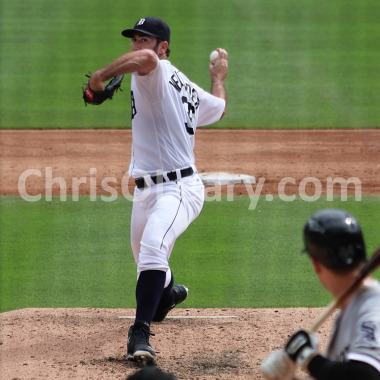
Justin Verlander
2016
Prior to 2020, JV was the only pitcher at the MLB level
who (still) moved naturally.
Like a starting pitcher.
Like Ryan, Seaver, Gibson, Rivera, Maddux and all the
other dominant and durable greats of the past.
And then the conventional wisdom got him.
Ron Wolforth told Verlander he needed to change his
pitching mechanics and become more consistent with the
conventional wisdom, leading him to break.
Completely predictably.
November 13, 2019
I get into why Verlander came crashing down to earth in detail in
Pitching
Mechanics: The Problem and
Justin Verlander: What Happened but in this piece I want to discuss
what JV did — or was doing — right.
And what changed.
Best Pitching Mechanics
What pitcher has the best pitching mechanics?
I answer that question at length in my piece that discusses the
best pitching
mechanics but, in sum, my list of the best pitchers looks for
two things.
- Dominance
- Durability
Using those criteria, my list of the pitchers with the best
pitching mechanics includes...
- Nolan Ryan
- Tom Seaver
- Bob Gibson
- Mariano Rivera
- Greg Maddux
As for modern pitchers?
No, Aroldis Chapman hasn't been completely injury-free. But
that's what you get when you throw 105. Relatively speaking,
compared other super-hard throwers, Chapman has been remarkably
durable.
Then there's...
...who I discuss below, at length.
In sum, Verlander is a GREAT example. As long as you ignore 2020.
And, to a lesser degree, his mechanics after 2014.
But I'd put 2009-2013 and 2016-2017 Justin Verlander up there
with Nolan Ryan and Tom Seaver, which is why it's so tragic that
Ron Wolforth decided he could improve on Verlander's mechanics.
Justin Verlander
I've been studying Justin Verlander's pitching mechanics since
2009, seeing in him someone who moved like Nolan Ryan, Tom Seaver,
and the other greats of the past.
A pitcher who moved completely naturally.
And well.

Justin Verlander
2012
And contrary to the conventional wisdom, as this 2012 clip,
which is one of my favorites and the one that opened my eyes
to the wisdom of Scap
Loading, shows all too well.
And then, in 2014, Justin Verlander got hurt.
In sum, what I think happened in 2014 and 2015 is that the only
thing I don't like about his pitching mechanics, what his
front leg and knee are doing in Frame 89...
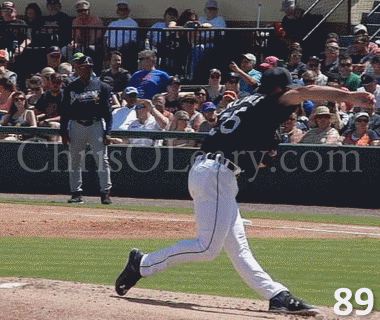
Justin Verlander
Frame 89
...caused a core injury — twice, now — leading
to problems up the kinetic chain.
In 2016, I went to Spring Training hoping to see the Justin
Verlander of old.
I was not disappointed.
So what's so great about the pitching mechanics I saw on display in
2016?
Proper Mechanics
When I look at Justin Verlander's 2016 pitching mechanics, I see
a pitching who is moving completely naturally.
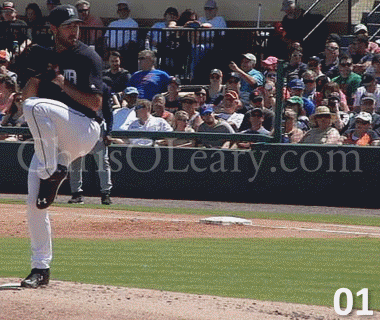
Justin Verlander
2016
Justin Verlander isn't using any of the tricks and shortcuts
that have become established as the conventional wisdom.
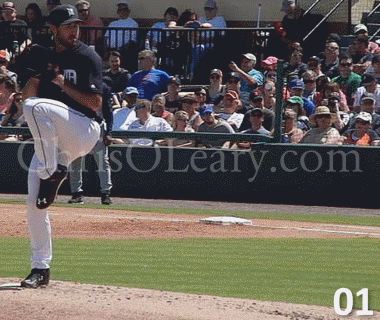
Justin Verlander
Frame 01

Justin Verlander
Frame 22
In Frame 22, Justin Verlander has completed the Drop portion
of the Drop & Drive movement and is just about to start to
Drive towards home plate.

Justin Verlander
Frame 39
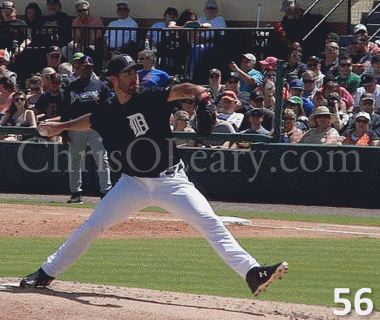
Justin Verlander
Frame 56
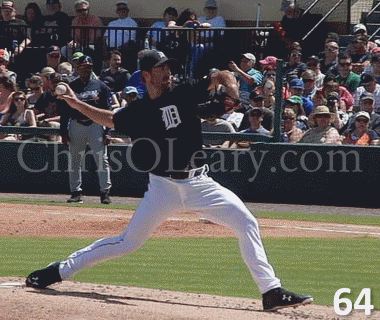
Justin Verlander
Frame 64
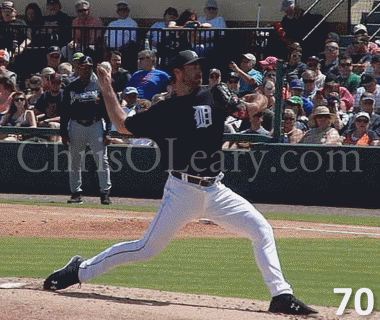
Justin Verlander
Frame 70
Frame 70 is where we can see Justin Verlander's excellent
Timing. His front foot is down, his shoulders are just about
to start turning, and his pitching arm is UP and ready to accept
the load.
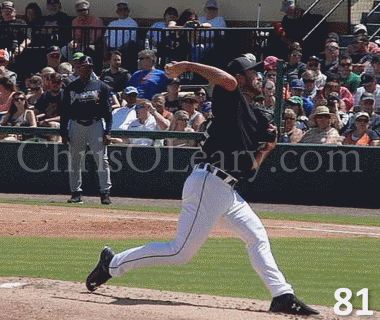
Justin Verlander
Frame 81
In Frame 81, Justin Verlander's pitching arm is at maximum
External Rotation, laying back towards second base.
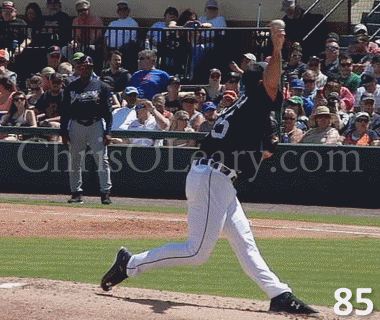
Justin Verlander
Frame 85
In Frame 85, Justin Verlander is just about to release the
ball. Notice that, while some say that pitchers need to keep
both feet on the ground, Verlander's back foot is (slightly) up
in the air, which is perfectly normal.

Justin Verlander
Frame 89
Frame 89 shows the only concern I have with Justin
Verlander's pitching mechanics; the way he (hyper) extends his
front knee and leg which, I'd suggest, is related to the
problems he has had with his core in 2014 and 2020. While this
works, it's not necessary.
Verlander: What Happened?
As I explain, in detail, in...
...Justin Verlander changed his pitching mechanics and
moved away from the classic, starter model and, instead,
became compatible with the Conventional Wisdom.
Where to go from Here
I have put together a number of free and other pieces for
people who want to dive into the topic of pitching mechanics.
Pitcher Injury Predictions
Since 2006, I have been making predictions about which
pitchers I think are more, and less, likely to experience injury
problems.
I mention this because I believe it establishes that I have a
deep understanding of pitching mechanics and injuries; you have
to understand a system in order to make accurate predictions
about it.
Professional Pitcher Analyses
In order to help people understand how major league pitchers
actually throw the ball, I have created a
number of analyses of the
pitching mechanics of major league
baseball pitchers, including...
|













